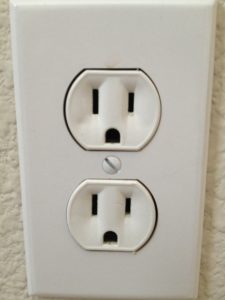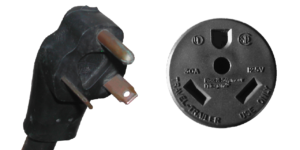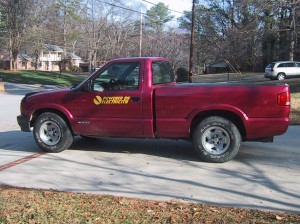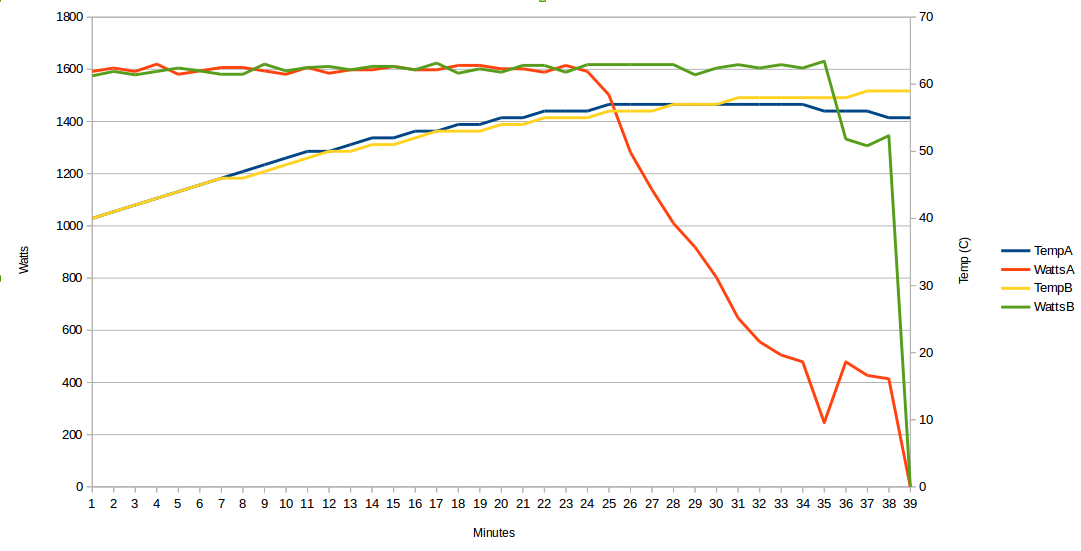Did you have an electric vehicle and want to start charging it with a Level 2 (240 volt) EVSE (charger) instead of the Level 1 EVSE (120 volt trickle charger) that came with the vehicle?
How much this will cost you depends upon a lot of factors, and in this post I will outline all of the different options.
How much power does your EV need?
Your vehicle’s charger will automatically work with any EVSE, regardless of the number of amps it provides. In some cases, the vehicle’s onboard charger is the limiting factor, while in other cases the EVSE or electrical circuit it is plugged into is the limiting factor.
For example, older Nissan Leafs may come with a 3.3 kW charger, or a 6.6 kW charger if you paid extra for the DC fast charge port or the “charging package”. If it has a 3.3 kW (3,300 watts) the maximum current it can draw at 240 volts is 3300/240 = 13.75 Amps, so a 16 Amp charger on a 20 amp 240 volt outlet will provide plenty of power. This means that a NEMA 6-20 receptacle is all you currently need to add to your garage to fully charge your current EV. (But won’t provide much room for future growth).
If you have a 6.6 kW charger, at 240 volts it will draw a maximum of 6600 / 240 = 27.5 amps, so a 30 amp charger (requiring a 40 amp circuit) is plenty, and even a 24 amp charger in a 10-30 or 14-30 outlet (30 amp circuit) will provide 87% of the power your car’s charger can use.
If you don’t know (and can’t find out) the power of your vehicle’s onboard charger, I recommend installing a 50 amp circuit (14-50 receptacle) with a 40 amp EVSE, which can provide 40amps*240volts = 9,600 or 9.6 kW of charging power. This will allow you to charge most modern EV’s at their full rate and provide a little room for growth.
Terminology: EVSEs vs Chargers vs Outlets (and Amps), L1, L2, L3 DCFC
An EVSE (Electric Vehicle Service Equipment) is the box that goes between the wall outlet and the J-1772 plug on your vehicle. People commonly call them EV chargers, but they are really just smart “on/off” boxes that tell the car how much current it can draw and turn off power when you push the button on the J-1772 “gun” to remove it from the car. (They also protect against ground faults and other wiring mistakes…)
The “charger” is built into your vehicle, and converts 120 or 240 volt AC current into DC power to charge the vehicle battery (typically near 400 volts). It has a maximum power capacity typically measured in watts. [Watts = Amps * Volts]. The charger in your vehicle is what ultimately determines the maximum charging speed with a L1/L2 EVSE.
L1 (Level 1) EVSE’s typically operate at 120 volts and under 12 amps. They come with NEMA 5-15 plugs to plug into any normal house outlet that look like this:

L2 (Level 2) EVSE’s typically operate at 240 volts (but most also support 120 volt operation) at amp ratings higher than 12A (Common ramp ratings are 16, 24, 40).
Cars with DC Fast Charging ports bypass the charger when using them, and connect the battery of the car directly to the DC fast charger (commonly called a Level 3 or L3 charger), so DCFC can charge your car faster than the onboard charger.
Receptacles/Outlets (into which EVSEs are plugged) are powered by “circuits” (wires) from your main electrical panel and these circuits are rated by the amp rating of the circuit breaker in the panel. The circuit breakers are sized appropriately to protect the wire in the wall from bursting into flames if too much current is pulled through the wire, so you can not just swap out to a higher amperage circuit breaker to “upgrade” a circuit. To get a higher amperage circuit, you need to draw new (thicker, lower gauge) wire between the electrical panel and the receptacle to be installed. [Note however that it is possible to upgrade the VOLTAGE of a circuit, so it is possible to upgrade a 120 volt 20 amp circuit to a 240 volt 20 amp circuit just by replacing the circuit breaker and the receptacle with 240 volt versions. The wire is rated by amps, and all home wiring is rated for well over 240 volt operation.]
80 Percent De-rating for Continuous Usage, and EVSE Amp Ratings
Power circuits and receptacles in your home are rated at their “maximum” amp rating. So a typical household 120 volt NEMA 5-15 outlet on a 15 amp circuit can have a maximum of 15 amps drawn from it and the circuit will have a 15 amp circuit breaker. [In the US, many 15 amp circuits are wired with 12 gauge wire that can support 20 amps, even though they are protected with a 15 amp breaker and use 15 amp receptacles.]
However, when drawing power continuously, the electrical code requires an 80% “de-rating”. So you should only draw 12 amps continuous from a 15 amp circuit. (15 * 0.80 = 12). This is why so many 120 volt L1 “Trickle chargers” that come from the factory with EV’s will only charge at 12 (or 8!) amps when plugged into a 120 volt outlet.
It is also why a 24 amp EVSE will come with a 10-30 or 14-30 plug and be designed to plug into a 30 amp circuit (30 * 0.80 = 24), and 40 amp EVSE’s are designed to be plugged into a 50 amp circuit with a NEMA 14-50 plug (50 * 0.80 = 40). There are also 16 amp EVSE’s designed for 20 amp circuits that use NEMA 6-20 plugs for 240 volt circuits, but typically also include a adapter that allows them to be plugged into a standard NEMA 5-15 outlet. When they detect 120 volts, they limit the provided amps to 12 or 8 unless they know it’s a 20 amp circuit.
Your Easiest and Best Option
Hire a licensed electrician to install a 50 amp circuit to a NEMA 14-50 receptacle mounted near where you want to charge your vehicle. Buy a 40 amp EVSE that plugs into a 14-50 receptacle, and that will give you up to 9.6 kW of charging power which will fully cover the needs of most EV’s today.
A new NEMA 14-50 circuit/recepticle should cost you between $200-$1000, depending upon the distance between the receptacle location and the panel the circuit breaker is in. If mounting outdoors, I recommend an outdoor rated “RV” style enclosure. You should buy the enclosure/outlet yourself and have it on-hand when asking the electrician to install it. (Many electricians won’t have this particular RV style outdoor enclosure on the truck, and will want to install one that doesn’t have an “in-use” weather protection cover.)
The 40 amp EVSE will set you back another $300-650 depending upon options. I’m using a JuiceBox Pro due to the connected features that allow me to set a charging start/stop time, limit current draw, only charge to 80%, etc….but a basic “plug it in and charge” EVSE is a lot cheaper.
Cheapest Option
Have you considered just using your existing L1 charger that came with the EV? If you plug in overnight every day, that is 10-15 kWh of power added to your EV every day. If you don’t make many long trips, or many back-to-back trips, you may find that this is enough power for your day-to-day usage. Many people are surprised to find that a L1 charger will cover most of their daily driving needs. [This is especially true if you have a larger (40-100 kWh) battery pack and use DC fast chargers for long trips.]
Cheaper Options
The cheapest option is to make use of an existing outlet and not involve an electrician.

The two receptacles illustrated above are a NEMA 14-30 (left: 30 amp – 240 volt) and NEMA 14-50 (right: 50 amp-240 volt) outlets. If you have one of these already in your garage (or outside for a large RV hookup) you are golden! Just buy a 24 amp EVSE that plugs into a NEMA 14-30, or a 40 amp EVSE that plugs into a 14-50 and you are ready to charge!
However, unless your house is relatively new, you are much more likely to find a NEMA 10-30 outlet for a clothes dryer. The NEMA 10 outlets are 240 volts, but do not include a dedicated ground. (The neutral is supposed to be tied to ground where your power enters your house.) A NEMA 6-50 includes a ground with no neutral….
Any of these outlets can be used to charge a vehicle at 240 volts, you just need to buy an EVSE with the appropriate plug (or adapter). Again, the 30 amp outlets support a 24 amp EVSE, while the 50 amp outlets support a 40 amp EVSE.
If you do not want to have to unplug your EVSE to re-plug your clothes dryer every time you do Laundary, SplitVolt makes a “plug sharing” box that will prioritize your clothes dryer when it is in use, but then enable your EVSE any other time.
Weirder and Smaller 240 volt Outlets
If you are especially lucky, you may find that your garage already comes equipped with a 240 volt outlet. A previous resident may have had a welder or plasma cutter outlet installed, which may be a circular “Locking” NEMA outlet.

Many of the L6 (locking 6) receptacles look very similar, with only minor differences in the plug blade sizes to differentiate them. Look for markings or compare them to photos online, but the best way to confirm what you have is to go to a hardware store and buy a plug of the appropriate type and make sure it fits. Once you identify what type (and amperage you have), you can buy an adapter that will go from the “twist lock” style to a the type of receptacle most EVSE’s use (the “non-Locking” style). Some examples:
L6-20 to 6-20
L6-30 to 6-30
L6-50 to 6-50
Note that although you CAN find L6-30 to 6-50 adapters, you SHOULD NOT USE THEM unless your EVSE is a 24 amp or less. Using a 40 amp EVSE connected to a 30 amp outlet via that type of adapter will lead to tripping circuit breakers (best case) or fires (worst case). In general, you should never use an adapter that plugs into a lower amp rated receptacle and converts it to a higher amp rated receptacle.
You may even find a 240 volt NEMA 6-15 or 6-20 receptacle, which may be used for larger window air conditioner or 240 volt space heater application.

A NEMA 6-20 240 volt 20 amp outlet is best, as there are several 16 amp 240 volt EVSE’s that will plug directly into them.
But, a 6-15 can be used with many 120 / 240 volt dual voltage compatible L1 EVSEs at 12 amps or less. The advantage over a normal 120 volt 5-15 outlet is that because the voltage is doubled, the total power (watts) is also doubled. While 12 amps at 120 volts is only 1.4 kW of charging power, 12 amps at 240 volts is 2.8 kW of charging power. You may need to re-wire the plug of your 240 volt compatible L1 charger with a 6-15 plug, and then buy a 5-15P to 6-15R adapter if you ever want to use that L1 charger on a normal 120 volt outlet. [That adapter allows you to plug a 240 volt appliance (that hopefully also automatically works with 120 volts) into a 120 volt outlet, which is kind of sketchy, but nowhere near as dangerous as plugging a 120 volt appliance into a 240 volt outlet!]
Upgrading a 5-15 to a 6-15 or 6-20
If you have a dedicated 120 volt 15 amp circuit running from your electrical panel to a single outlet using 12 gauge wire, you can pay an electrician to upgrade that circuit to a 240 volt 20 amp circuit (if the wire run is short enough).
They can swap the 15 or 20 amp 120 volt breaker for a 15 or 20 amp 240 volt breaker, and replace the recepticle with a 6-15 or 6-20 240 volt receptacle. Because they don’t need to replace or re-pull any wire, this can be less expensive than installing a new 14-50 circuit.
Many “15 amp” circuits are wired with 12 gauge wire in the US, which can be upgraded to 20 amps. [If the wire run is long, it may need to go to 10 guage wire for a 20 amp circuit.] However, some circuits are using 14 gauge wire, which can’t support more than 15 amps. Your electrician will need to verify the wire gauge before upgrading a 15 amp circuit to a 20 amp circuit.
This only works if there is only a single outlet on the circuit (dedicated circuit), and has the disadvantage that you lose the use of a 120 volt outlet, so is only useful in certain limited situations.
TT-30 outlets
If you have an RV outlet, it’s probably a 14-50 (for big RVs) which is great for using with an EVSE or (more likely) a TT-30 (Travel Trailer 120 volt 30 amp) outlet that looks like this:

A TT-30 outlet can be used to charge an EV, but it is difficult to make full use of the 30 amps at 120 volts. Many EVSE’s that auto-switch between 240 volts and 120 volts will assume any 120 volt input is on a 15 amp outlet, and will current limit to 12 amps of charging power (80% of the circuit rating). Probably your best bet is to buy a TT-30P to 5-15R adapter and just use the L1 EVSE that came with your vehicle. It won’t be very fast, but it’s better than no outlet, and will get your vehicle charged at 120volts * 12 amps = 1.4 kW.
Even if your EVSE supports 24 amps at 120 volts, some EV’s have on-board chargers that also limit current if a 120 volt input is detected. You’ll have to check your car’s specific specifications and manuals to determine if it has this “feature” or not. (Some of them allow you to pick 6, 8,12, or 16 amps when a 120 volt circuit is detected using a menu on the dashboard.)
If you wanted to break some electrical codes, you could buy a TT-30 Plug, some 10 gauge wire, and a NEMA 10-30 receptacle and make an adapter that provides 120 volts at 30 amps to a 240 volt – 30 amp receptacle.
The trick is to find a 24 amp EVSE that will be happy to provide 24 amps using 120 volts. This requires an EVSE that can work on 120 or 240 volts, but that isn’t smart enough to try and current limit to 12 amps when it sees 120 volts.
Your best bet is to try EVSE’s that are designed for 240 volts with 10-30 plugs that don’t include an adapter to work with a 5-15 (120 volt) plug.
After you confirm that the EVSE operates successfully at 120 volts while providing the full 24 amps, you can cut the 10-30 or 14-30 plug off of it, and attach the TT-30 plug directly to the end of the wire of the EVSE to make things more code compliant…but I wouldn’t do that until you confirm that the EVSE will work at 24 amps and 120 volts, or perhaps until after the EVSE warranty is up. I’ve never tested this with a specific EVSE, so if you find one that you can confirm works, please leave a comment with the brand/model.
Notes:
1. If you have a Tesla with the upgraded charger package, you may want an 80 amp circuit if you want to refill your 100 kWh battery in less than 10 hours, but if you have one of those, you probably don’t need to read this page.



on copart.com in oregon theres blue 2012 nissan leaf showing _ _ _ on the gom.
your youtube video showed very well how to fix simaliar issues as this car. using leaf spypro. but the car in the auction has no damage, so does that mean the charge is bad or can leaf spy fix a code for that.??
— on the GOM means that the battery state of charge is low (but does not indicate the battery state of health).
Given that it is a 2012 Leaf, it probably has a relatively low state of health left on the battery.
This video I made give some context on how to read the battery display on Gen1 Leafs.
https://www.youtube.com/watch?v=WZxRTkWV7Fw